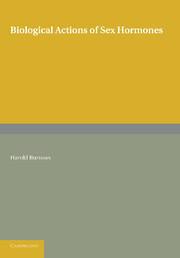Book contents
- Frontmatter
- CONTENTS
- PREFACE
- PART I GONADOTROPHINS
- CHAPTER I The Nature and Functions of Gonadotrophins
- CHAPTER II Factors which Influence the Gonadotrophic Activity of the Pituitary
- CHAPTER III Factors which influence the Reaction of the Gonads to Gonadotrophins
- CHAPTER IV Factors which affect the Cytological Structure and Weight of the Anterior Lobe of the Pituitary
- PART II GONADAL HORMONES
- PART III ANDROGENS
- PART IV OESTROGENS
- PART V PROGESTINS
- PART VI SEX HORMONES OF THE ADRENAL CORTEX
- APPENDIX
- REFERENCES
- GLOSSARY
- INDEX
CHAPTER II - Factors which Influence the Gonadotrophic Activity of the Pituitary
from PART I - GONADOTROPHINS
Published online by Cambridge University Press: 05 June 2016
- Frontmatter
- CONTENTS
- PREFACE
- PART I GONADOTROPHINS
- CHAPTER I The Nature and Functions of Gonadotrophins
- CHAPTER II Factors which Influence the Gonadotrophic Activity of the Pituitary
- CHAPTER III Factors which influence the Reaction of the Gonads to Gonadotrophins
- CHAPTER IV Factors which affect the Cytological Structure and Weight of the Anterior Lobe of the Pituitary
- PART II GONADAL HORMONES
- PART III ANDROGENS
- PART IV OESTROGENS
- PART V PROGESTINS
- PART VI SEX HORMONES OF THE ADRENAL CORTEX
- APPENDIX
- REFERENCES
- GLOSSARY
- INDEX
Summary
Age. Afferent nervous stimuli. Changes of external temperature. Seasons. Oestrous cycle. Pregnancy. Gonadectomy. Partial gonadectomy, cryptorchidism and sterilization by X-rays. Gonadal hormones. Gonadotrophins. Sex. Nutrition.
THE pituitary by its power to supply trophins to the gonads is the mainspring of reproductive activity, and it may be of interest to consider some of the circumstances which affect this gonadotrophic function.
Age
The pituitary may produce some gonadotrophin at an early stage of existence. Smith & Dortzbach (1929) implanted pituitaries from foetal pigs into immature female mice. With the pituitaries of foetal pigs having a crown-rump length of 14 to 15 cm., no response was obtained; those from embryos measuring 18 cm. or more gave a positive result, namely follicular maturation, distension of the uterus and opening of the vagina. The gonadotrophic content of the foetal pig's pituitary, as indicated by these experiments, increased rapidly after the foetus had attained a length of 20 cm.
Hellbaum (1935) made comparative tests of the gonadotrophic potencies of pituitaries taken from foetal, immature and adult horses, and from mares and geldings. Positive tests were given by the pituitaries of foetal and immature horses, though the effect was less than that produced by the pituitaries of adults when given in equal quantity. Smith & Engle (1927) showed that infantile rats between 5 and 30 days after birth produced some gonadotrophin, for their pituitaries, when implanted into 17-day-old mice at the rate of two to six pituitaries daily, caused opening of the vagina and other signs of precocious maturity; and Clark (1935) by similar methods found that a sharp rise in the gonadotrophic potency of the rat's pituitary occurred between the 13th and 20th day of postnatal life. Wolfe & Cleveland (1931) tested the capacity of anterior pituitary extracts prepared from immature and mature rabbits to induce ovulation in sexually mature rabbits. The extracts were injected into the marginal ear vein of the test animal, whose ovaries were examined 24 hours later. Using amounts of extract which represented equal weights of pituitary gland, they found that the pituitaries of rabbits aged from 10 to 14 weeks were as potent, or nearly so, as those of adults. On the other hand the pituitaries of rabbits 4 or 5 weeks old, given in comparable doses, always failed to cause ovulation.
- Type
- Chapter
- Information
- Biological Actions of Sex Hormones , pp. 32 - 69Publisher: Cambridge University PressPrint publication year: 2013



